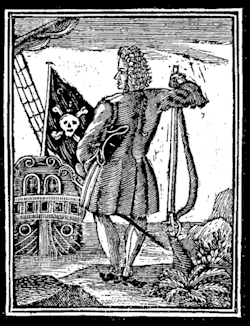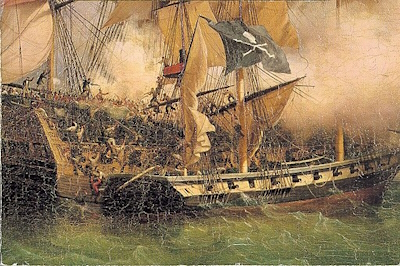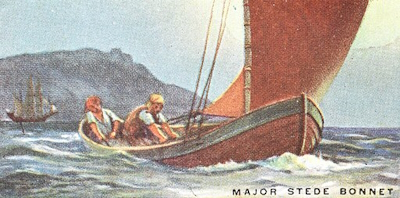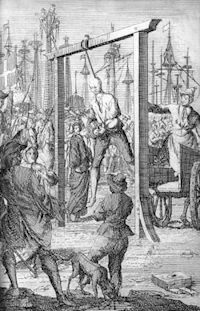 Stede Bonnet is sometimes referred to as ‘The Gentleman Pirate’. Historically, he has often been viewed as more of a comical or tragic figure, who wasn’t always taken seriously. This image was probably fuelled by his inexperience in matters of seamanship. He was a descendant of Oliver Cromwell and a distant relative of Woodes Rogers. Born on Barbados in about 1688 and his parents, Edward and Sarah Bonnet, owned an estate of over 400 acres south-east of Bridgetown, which he inherited in 1694. He was well-educated and gained the rank of major in the Barbadian militia, although there is no record he was ever involved in any combat. He was made a justice of the peace a year before he turned to piracy. He married Mary Allamby in November 1709 and had three sons and a daughter with her. It has been speculated that he suffered from depression or some other sort of mental disorder, possibly caused by the death of his eldest son in 1715. A General History of the Pyrates claims his marriage was an unhappy one and that this was the real reason Bonnet turned to piracy. It remains unknown exactly why he became a pirate, although being a well-off landowner, it is possible he grew bored with his lot and simply desired adventure, probably even regretting his rash choice later on. It is unknown if his wife was aware of his plans. Bonnet also harboured Jacobite sympathies like many other pirates, which might have influenced his decision to take to the seas.
Stede Bonnet is sometimes referred to as ‘The Gentleman Pirate’. Historically, he has often been viewed as more of a comical or tragic figure, who wasn’t always taken seriously. This image was probably fuelled by his inexperience in matters of seamanship. He was a descendant of Oliver Cromwell and a distant relative of Woodes Rogers. Born on Barbados in about 1688 and his parents, Edward and Sarah Bonnet, owned an estate of over 400 acres south-east of Bridgetown, which he inherited in 1694. He was well-educated and gained the rank of major in the Barbadian militia, although there is no record he was ever involved in any combat. He was made a justice of the peace a year before he turned to piracy. He married Mary Allamby in November 1709 and had three sons and a daughter with her. It has been speculated that he suffered from depression or some other sort of mental disorder, possibly caused by the death of his eldest son in 1715. A General History of the Pyrates claims his marriage was an unhappy one and that this was the real reason Bonnet turned to piracy. It remains unknown exactly why he became a pirate, although being a well-off landowner, it is possible he grew bored with his lot and simply desired adventure, probably even regretting his rash choice later on. It is unknown if his wife was aware of his plans. Bonnet also harboured Jacobite sympathies like many other pirates, which might have influenced his decision to take to the seas.
Bonnet’s pirating career gets underway
In March 1717, Bonnet bought a 60-ton sloop named Revenge with his own money for £1700, which he had fitted out to his requirements. It wasn’t unusual at the time for a wealthy gentleman to own a ship for trade or recreational purposes, or even for pirate-hunting. He subsequently recruited a crew of as many as 70 men. According to A General History of the Pyrates, the men were paid set wages as opposed to the plunder pirates normally lived on. Bonnet didn’t have any sailing experience, but was, through his many books, probably knowledgeable on the subject of pirates and privateers. The Revenge sailed out of Barbados without informing anyone of their departure, heading for the east coast of North America, where Bonnet believed he wouldn’t be recognised. Although he used the alias Captain Edwards, he was recognized by a man from Barbados despite his attempts to conceal his true identity. Off the coast of Virginia he captured four vessels and burned a Barbadian ship called Turnes to prevent news of his exploits reaching home too quickly. He later took more vessels off the coast of New York and the Carolinas. Bonnet then sailed south hoping to fish the wrecks of the Spanish treasure fleet that had gone down in 1715. On his way there, he engaged a vessel, believing it to be a merchant ship, but which turned out to be a Spanish man-o-war and he was forced to retreat after he was injured and the crew had sustained heavy casualties. He then made his way to the pirate haven of Nassau on New Providence in order to repair and refit his damaged ship.
Bonnet and Blackbeard
 Either in Nassau or elsewhere in the Bahamas, Bonnet met Benjamin Hornigold and Blackbeard. He temporarily ceded his ship’s command to Blackbeard, who considered the sloop superior to his own. Some claim Bonnet was held prisoner, but if so, it was probably for his own good, not being an experienced seaman. He spent the time recovering from his wounds. In September 1717, he sailed together with Blackbeard to the east coast of North America to Delaware Bay, where they seized eleven ships and then on to the Windward Islands, where Blackbeard captured a French ship called La Concorde, which later became the infamous Queen Anne’s Revenge. The Revenge was returned to Bonnet and both ships sailed together, eventually reaching the Mexican coast, where Blackbeard careened his ship. In the meantime, Bonnet set out on his own, encountering the larger and better-armed Protestant Caesar. After a 3-hour exchange of fire, Bonnet retreated, which was a clear embarrassment for the fearsome reputation of pirates in general. After the defeat much of his crew deserted him for Blackbeard. It is thought that Blackbeard had Bonnet replaced on the Revenge by a man called Richards. Bonnet now was on the Queen Anne’s Revenge either as a guest or prisoner. The Protestant Caesar was hunted down and burnt by the vengeful Blackbeard, although its crew was spared. Bonnet then went north with Blackboard, ending up blockading Charles Town for medicines. On 10th June 1718, on the return journey, the Queen Anne’s Revenge ran aground at Topsail Island and was lost.
Either in Nassau or elsewhere in the Bahamas, Bonnet met Benjamin Hornigold and Blackbeard. He temporarily ceded his ship’s command to Blackbeard, who considered the sloop superior to his own. Some claim Bonnet was held prisoner, but if so, it was probably for his own good, not being an experienced seaman. He spent the time recovering from his wounds. In September 1717, he sailed together with Blackbeard to the east coast of North America to Delaware Bay, where they seized eleven ships and then on to the Windward Islands, where Blackbeard captured a French ship called La Concorde, which later became the infamous Queen Anne’s Revenge. The Revenge was returned to Bonnet and both ships sailed together, eventually reaching the Mexican coast, where Blackbeard careened his ship. In the meantime, Bonnet set out on his own, encountering the larger and better-armed Protestant Caesar. After a 3-hour exchange of fire, Bonnet retreated, which was a clear embarrassment for the fearsome reputation of pirates in general. After the defeat much of his crew deserted him for Blackbeard. It is thought that Blackbeard had Bonnet replaced on the Revenge by a man called Richards. Bonnet now was on the Queen Anne’s Revenge either as a guest or prisoner. The Protestant Caesar was hunted down and burnt by the vengeful Blackbeard, although its crew was spared. Bonnet then went north with Blackboard, ending up blockading Charles Town for medicines. On 10th June 1718, on the return journey, the Queen Anne’s Revenge ran aground at Topsail Island and was lost.
After the sinking of Queen Anne’s Revenge, whether it was intentional or by accident, Bonnet is thought to have made his way to Bath Town in North Carolina together with Blackbeard and while there obtained a pardon from Governor Charles Eden. He then hoped to sail to the Danish colony of St. Thomas to obtain a letter of marque against the Spanish, who had again been at war with Britain since July 1718. Blackbeard had left Bath before Bonnet and when the latter returned to Topsail Inlet, where most of his crew were waiting for him, he discovered that Blackbeard had already left with most of the provisions, although he had left behind the Revenge. It is said some of his men had been stranded on a sandbar after disagreeing with Blackbeard. On his return, Bonnet gathered his men and resumed command of them and his vessel. It is said that Bonnet then intended to seek out Blackbeard at Ocracoke Island, either to rejoin him or to seek revenge for being abandoned, although the latter seems unlikely, as Blackbeard had left Bonnet’s ship and crew intact.
Bonnet’s fate
 After accepting the King’s pardon, Bonnet captured a further eleven ships. He plundered some English vessels, which he tried to pass it off as trade so as not to endanger his pardon. He went under the name Captain Thomas to disguise his real identity. He also changed the name of the Revenge to Royal James, which further revealed his Jacobite sympathies. In August, the Royal James began to leak, so Bonnet sailed to Cape Fear River for repairs, after which he planned to wait for the end of the hurricane season before sailing to St. Thomas. Unfortunately for Bonnet and his crew, their location had become known and two 8-gun sloops, Henry and Sea Nymph, were sent out after him by the governor of South Carolina, Robert Johnson, under the command of Colonel William Rhett, who had previously been searching in vain for Charles Vane. Bonnet’s men first thought the two sloops were potential prizes, but soon realised they were pirate-hunters. At first, the two sloops ran aground, as did the Royal James while trying to make its escape, but Bonnet was eventually captured after a 5-hour exchange of fire, ending when the tide rose to free the two sloops but not the Royal James. Twelve of Rhett’s men were killed and eighteen wounded, while the pirates lost seven men and five wounded.
After accepting the King’s pardon, Bonnet captured a further eleven ships. He plundered some English vessels, which he tried to pass it off as trade so as not to endanger his pardon. He went under the name Captain Thomas to disguise his real identity. He also changed the name of the Revenge to Royal James, which further revealed his Jacobite sympathies. In August, the Royal James began to leak, so Bonnet sailed to Cape Fear River for repairs, after which he planned to wait for the end of the hurricane season before sailing to St. Thomas. Unfortunately for Bonnet and his crew, their location had become known and two 8-gun sloops, Henry and Sea Nymph, were sent out after him by the governor of South Carolina, Robert Johnson, under the command of Colonel William Rhett, who had previously been searching in vain for Charles Vane. Bonnet’s men first thought the two sloops were potential prizes, but soon realised they were pirate-hunters. At first, the two sloops ran aground, as did the Royal James while trying to make its escape, but Bonnet was eventually captured after a 5-hour exchange of fire, ending when the tide rose to free the two sloops but not the Royal James. Twelve of Rhett’s men were killed and eighteen wounded, while the pirates lost seven men and five wounded.
 Bonnet was taken to Charles Town for trial. Two of his men, Ignatius Pell And James Herriot agreed to testify against Bonnet and the rest, although, for some reason, the latter helped his former captain escape three days later on 26th October, both dressed in women’s clothing. The Governor reacted by putting a bounty of £700 on Bonnet’s head, and the pirate captain was soon recaptured after bad weather hampered his plan to escape by boat, stranding him on Sullivan’s Island. Herriot was killed and the two other accomplices wounded by the authorities during the capture. Bonnet was put on trial separately from the rest of his crew, during which he claimed he’d been forced back into piracy by his men. Despite popular support for the condemned pirate and his appeals to the Governor for clemency, Bonnet was found guilty of piracy and sentenced to death on 12th November by Judge Nicholas Trott. The Gentleman Pirate was finally hanged on 10th December, a month after 34 of his crew had been hanged. In period of one year, he’d captured 53 vessels and taken a considerable, but unknown amount of money.
Bonnet was taken to Charles Town for trial. Two of his men, Ignatius Pell And James Herriot agreed to testify against Bonnet and the rest, although, for some reason, the latter helped his former captain escape three days later on 26th October, both dressed in women’s clothing. The Governor reacted by putting a bounty of £700 on Bonnet’s head, and the pirate captain was soon recaptured after bad weather hampered his plan to escape by boat, stranding him on Sullivan’s Island. Herriot was killed and the two other accomplices wounded by the authorities during the capture. Bonnet was put on trial separately from the rest of his crew, during which he claimed he’d been forced back into piracy by his men. Despite popular support for the condemned pirate and his appeals to the Governor for clemency, Bonnet was found guilty of piracy and sentenced to death on 12th November by Judge Nicholas Trott. The Gentleman Pirate was finally hanged on 10th December, a month after 34 of his crew had been hanged. In period of one year, he’d captured 53 vessels and taken a considerable, but unknown amount of money.
Bonnet’s flag
 Bonnet has been attributed with flying a black flag with a skull over a bone with a dagger on one side and a heart on the other side of the skull. There is no evidence he ever used it. Period sources describe him as having flown a flag with a skull on it, similar to those of the Flying Gang.
Bonnet has been attributed with flying a black flag with a skull over a bone with a dagger on one side and a heart on the other side of the skull. There is no evidence he ever used it. Period sources describe him as having flown a flag with a skull on it, similar to those of the Flying Gang.
If you’re interested in learning more about Stede Bonnet, watch the video below by Gold and Gunpowder.
